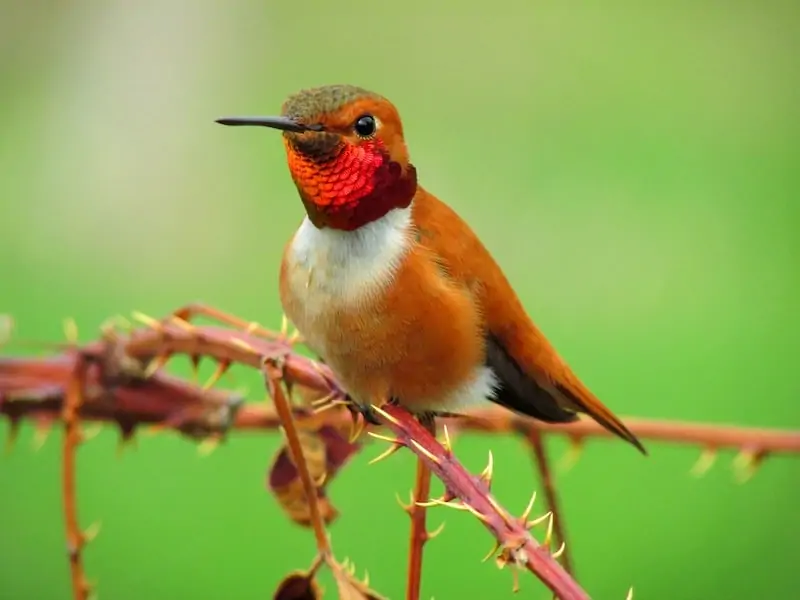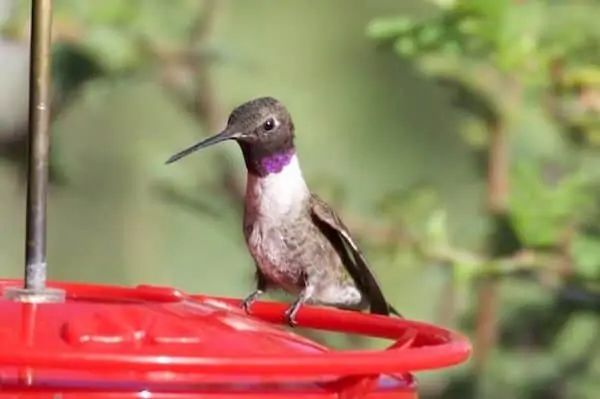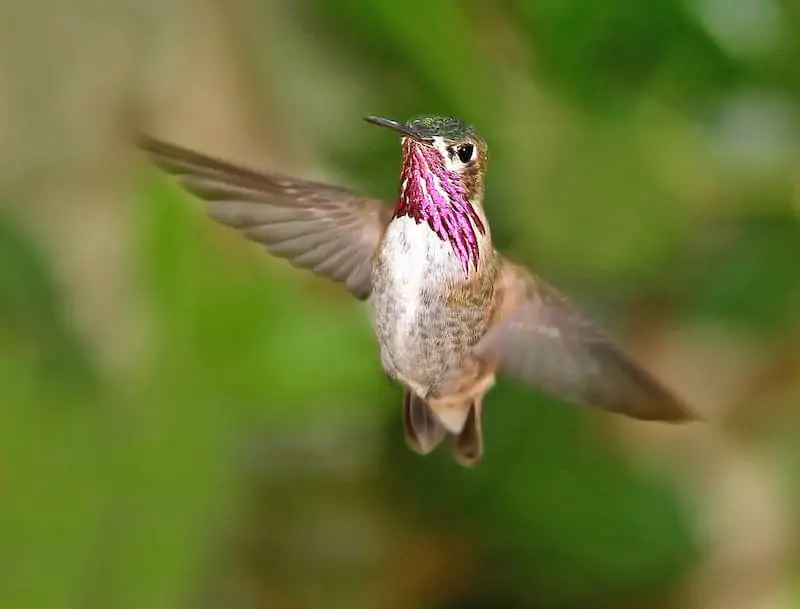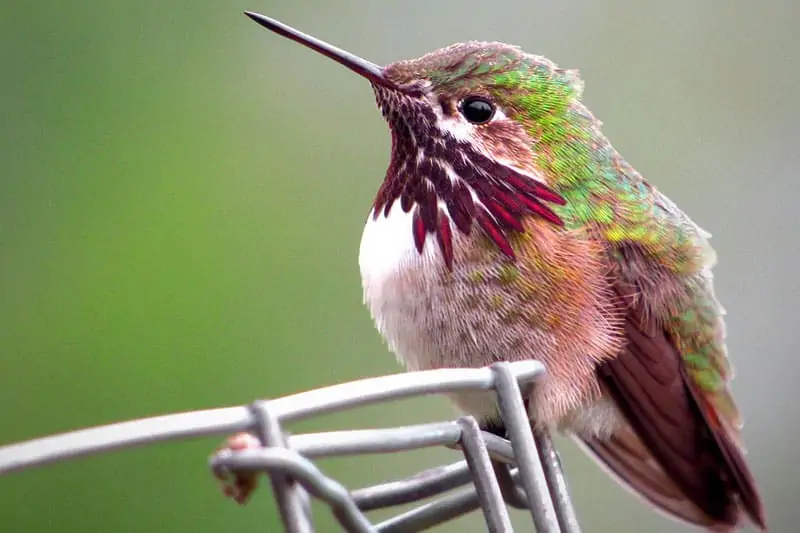Almost 30 different species of hummingbirds have been spotted in the United States, according to reports. Some are frequent, while others are uncommon or accidental visitors that appear every year or so. We have identified two common or semi-common species of hummingbirds in South Carolina, as well as two uncommon species. Hummingbirds have been seen in South Carolina multiple times, representing four different species.
4 HUMMINGBIRDS IN SOUTH CAROLINA
We’ve put together a list of hummingbirds that may be seen in South Carolina based on range maps from trustworthy sources such as allaboutbirds.org and ebird.org. The species name, pictures of what it looks like, characteristics about appearance, and where and when you may see them are all included for each species in this list. We’ll start with the most frequent species and work our way down to the less common ones.
Stay tuned until the conclusion of the article for advice on bringing hummingbirds to your yard, and check this page to see when they’ll be coming back to your area.
Enjoy!
1. RUBY-THROATED HUMMINGBIRD

Scientific name: Archilochus colubris
In the eastern part of the United States, Ruby-throated hummingbirds are the most prevalent hummingbird. Their backs are green, and their underparts are white. The throat of males is crimson, and in some lighting it may seem black.
Ruby-throated hummingbirds may be seen in South Carolina from early spring through late summer. Most head south in the autumn, with a few staying through the winter, particularly near the coast.
2. RUFOUS HUMMINGBIRD

Scientific name: Selasphorus rufus
When it comes to sharing feeders and fighting other hummers, rufous hummingbirds are well-known for being quite “feisty.” Males feature an orange breast with a white patch on the top and a scarlet neck. Green females with speckles on the throat and green males.
They go up through California in the spring, spend the summer in the Pacific Northwest and Canada, then zip back down through the Rockies in the fall. The rufous hummingbird is arguably the second most common sighted species on the east coast, behind the ruby-throated hummer, and is thought to be a western U.S. hummingbird.
There have been dozens of rufous sightings in South Carolina throughout the years, though it is not particularly common. The majority of the sightings I discovered took place throughout the winter.
3. BLACK-CHINNED HUMMINGBIRD

Scientific name: Archilochus alexandri
Every year, black-chinned hummingbirds travel north to breed in the western United States. They migrate from Mexico and Central America. In most light, the throat of males looks to be a plain black color, although they do have a small purple feather band along the bottom that may be visible. Females have a plain throat and green above and light below, much like other hummingbird females. They like to perch on bare branches and can be found in a variety of habitats, from deserts to mountain forests.
They have been seen in most states along the east coast, including South Carolina, where there have been a few sightings over the years. They are a bird of the west coast. Even though they aren’t particularly common in the state, you may get lucky.
4. CALLIOPE HUMMINGBIRD

Scientific name: Selasphorus calliope
The hummingbird migrates from Central America to the Pacific Northwest and areas of western Canada during the breeding season. The calliope is the tiniest bird in the United States, so that’s a long way to go, especially when you consider!
Males have a magenta stripe throat pattern that forks down on the sides that is unique to them. The throat and underparts of females are plain, with a peachy tint.
On the east coast, Calliope Hummingbirds are uncommon, however they have been sighted in South Carolina a few times near Columbia and Charleston.
ATTRACTING HUMMINGBIRDS TO YOUR YARD
1. HANG HUMMINGBIRD FEEDERS
Hanging a nectar feeder in your yard might be the best way to attract hummingbirds. Hummingbirds must eat constantly and have a reliable supply of nectar because they require it. Pick a feeder with a red color and that is simple to disassemble and clean. Cleaning and refilling should be done more often than once a week in hot weather. Most individuals should use a saucer-shaped feeder. They’re extremely simple to keep clean, operate properly, and don’t store an excessive quantity of nectar.
2. MAKE YOUR OWN NECTAR
By making your own nectar, you’ll be able to eliminate (and sometimes fatal) ingredients. It is inexpensive, simple, and fast. To make 1 cup of plain white sugar, mix 1 cup of water with a 1:4 ratio (1 cup sugar to 4 cups water). Our guides on making your own nectar without having to heat the water are simple to follow.
3. PLANT NATIVE FLOWERS
Plant some flowers in your yard that will draw passing hummingbirds, in addition to a feeder. Red (as well as orange, pink, and purple) flowers, as well as trumpet or tubular-shaped blossoms, are particularly appealing to them. Vertical planting might help you conserve your space. Long cascading vines of flowers may be placed on an obelisk trellis or a flat trellis attached to the side of your home for a great vertical surface. Hummingbirds may be attracted to these 20 plants and flowers.
4. PROVIDE WATER
Hummingbirds need water to drink and bathe. They will utilize baths with the proper “specifications,” despite the fact that they may find classic bird baths too deep. You can buy these fantastic hummingbird bath products, or you may try something simple in your own garden.
5. PROMOTE INSECTS
Sugar isn’t enough for most hummingbirds, so they must also eat protein. Little insects account for up to a third of their diet. Mosquitoes, fruit flies, spiders, and gnats are among the insects. By avoiding pesticides, you can help your hummers. Our 5 simple tips will help you feed hummingbirds with insect feeders and other strategies.
